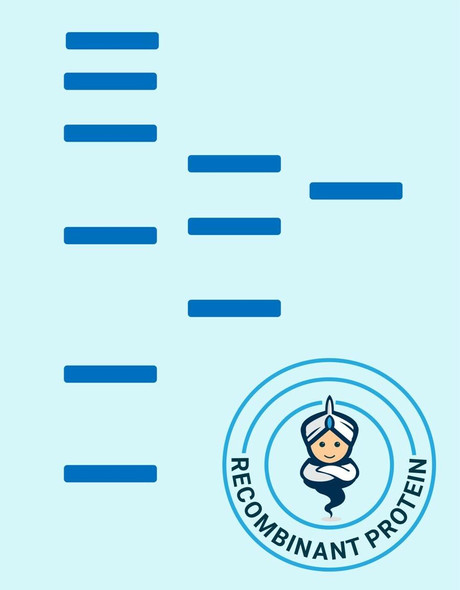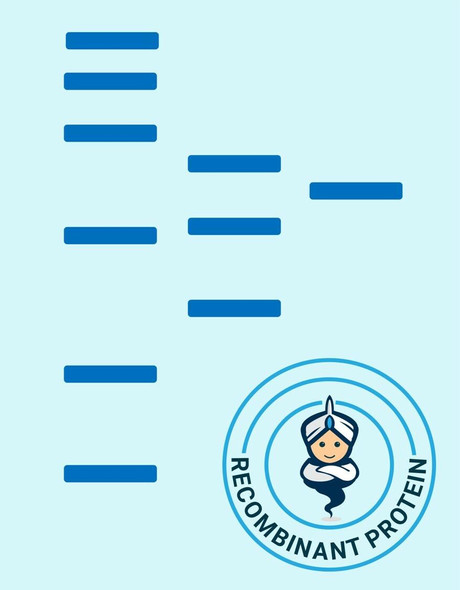Description
| Product Name: | Human FASLG Recombinant Protein |
| Product Code: | RPPB0197 |
| Size: | 20µg |
| Species: | Human |
| Target: | FASLG |
| Synonyms: | Tumor necrosis factor ligand superfamily member 6, Apoptosis antigen ligand, APTL, CD95 ligand, CD95-L, Fas antigen ligand, Fas ligand, FasL, CD178, FASLG, APT1LG1, CD95L, TNFSF6, ALPS1B. |
| Source: | Escherichia Coli |
| Physical Appearance: | Sterile Filtered colorless solution. |
| Formulation: | FASLG protein solution (1mg/ml) containing 20mM Tris-HCl buffer (pH 8.0), 0.4M urea and 10% glycerol. |
| Stability: | Store at 4°C if entire vial will be used within 2-4 weeks. Store, frozen at -20°C for longer periods of time. For long term storage it is recommended to add a carrier protein (0.1% HSA or BSA).Avoid multiple freeze-thaw cycles. |
| Purity: | Greater than 90% as determined by SDS-PAGE. |
| Amino Acid Sequence: | MGSSHHHHHH SSGLVPRGSH MQIGHPSPPP EKKELRKVAH LTGKSNSRSM PLEWEDTYGI VLLSGVKYKK GGLVINETGL YFVYSKVYFR GQSCNNLPLS HKVYMRNSKY PQDLVMMEGK MMSYCTTGQM WARSSYLGAV FNLTSADHLY VNVSELSLVN FEESQTFFGL YKL |
The type II transmembrane protein FASLG is a member of the tumor necrosis factor (TNF) superfamily. A fas ligand/receptor interaction has a significant part in the regulation of the immune system and the advancement of cancer. FASLG is expressed on the activated T cell surface as a nondisulfidelinked homotrimer. FASLG binding to Fas/CD95/TNFRSF6 on a nearby cell prompts apoptosis in the Fas expressing cell. FASLG is released from the cell surface by metalloproteinases as a soluble molecule that stays trimeric and is able to bind with Fas, but its capability to activate apoptosis is radically reduced. In addition, FASLG binds to DcR3 - a soluble trap receptor with no signal transduction capabilities. Flawed Fas-mediated apoptosis causes oncogenesis in addition to drug resistance in existing tumors. Constitutive expression of FASLG in a variety of tumors enables their immune evasion. Both mouse and human FASLG are active on mouse and human cells.
FASLG Human Recombinant produced in E.Coli is a single, non-glycosylated polypeptide chain containing 173 amino acids (130-281 a.a.) and having a molecular mass of 19.6kDa.FASLG is fused to a 21 amino acid His-tag at N-terminus & purified by proprietary chromatographic techniques.
| UniProt Protein Function: | FasL: Cytokine that binds to TNFRSF6/FAS, a receptor that transduces the apoptotic signal into cells. May be involved in cytotoxic T-cell mediated apoptosis and in T-cell development. TNFRSF6/FAS-mediated apoptosis may have a role in the induction of peripheral tolerance, in the antigen-stimulated suicide of mature T-cells, or both. Binding to the decoy receptor TNFRSF6B/DcR3 modulates its effects. Homotrimer (Probable). Interacts with ARHGAP9, BAIAP2L1, BTK, CACNB3, CACNB4, CRK, DLG2, DNMBP, DOCK4, EPS8L3, FGR, FYB, FYN, HCK, ITK, ITSN2, KALRN, LYN, MACC1, MIA, MPP4, MYO15A, NCF1, NCK1, NCK2, NCKIPSD, OSTF1, PIK3R1, PSTPIP1, RIMBP3C, SAMSN1, SH3GL3, SH3PXD2B, SH3PXD2A, SH3RF2, SKAP2, SNX33, SNX9, SORBS3, SPTA1, SRC, SRGAP1, SRGAP2, SRGAP3, TEC, TJP3 and YES1. Belongs to the tumor necrosis factor family. 2 isoforms of the human protein are produced by alternative splicing. |
| UniProt Protein Details: | Protein type:Membrane protein, integral; Apoptosis; Cytokine Chromosomal Location of Human Ortholog: 1q23 Cellular Component: extracellular space; lysosomal lumen; perinuclear region of cytoplasm; integral to plasma membrane; extracellular region; plasma membrane; caveola; nucleus; external side of plasma membrane Molecular Function:protein binding; death receptor binding; cytokine activity; tumor necrosis factor receptor binding; receptor binding Biological Process: caspase activation; positive regulation of I-kappaB kinase/NF-kappaB cascade; transcription, DNA-dependent; apoptosis; positive regulation of apoptosis; response to lipopolysaccharide; negative regulation of transcription from RNA polymerase II promoter; signal transduction; cellular chloride ion homeostasis; endosomal lumen acidification; inflammatory cell apoptosis; negative regulation of angiogenesis; induction of apoptosis via death domain receptors; cell-cell signaling; positive regulation of epidermal growth factor receptor signaling pathway; positive regulation of neuron apoptosis; positive regulation of cell proliferation; immune response; retinal cell programmed cell death Disease: Lung Cancer; Autoimmune Lymphoproliferative Syndrome |
| NCBI Summary: | This gene is a member of the tumor necrosis factor superfamily. The primary function of the encoded transmembrane protein is the induction of apoptosis triggered by binding to FAS. The FAS/FASLG signaling pathway is essential for immune system regulation, including activation-induced cell death (AICD) of T cells and cytotoxic T lymphocyte induced cell death. It has also been implicated in the progression of several cancers. Defects in this gene may be related to some cases of systemic lupus erythematosus (SLE). Alternatively spliced transcript variants have been described. [provided by RefSeq, Nov 2014] |
| UniProt Code: | P48023 |
| NCBI GenInfo Identifier: | 1345957 |
| NCBI Gene ID: | 356 |
| NCBI Accession: | P48023.1 |
| UniProt Secondary Accession: | P48023,Q9BZP9, |
| UniProt Related Accession: | P48023 |
| Molecular Weight: | 14,006 Da |
| NCBI Full Name: | Tumor necrosis factor ligand superfamily member 6 |
| NCBI Synonym Full Names: | Fas ligand (TNF superfamily, member 6) |
| NCBI Official Symbol: | FASLG�� |
| NCBI Official Synonym Symbols: | APTL; FASL; CD178; CD95L; ALPS1B; CD95-L; TNFSF6; APT1LG1�� |
| NCBI Protein Information: | tumor necrosis factor ligand superfamily member 6; CD95 ligand; fas antigen ligand; apoptosis antigen ligand; apoptosis (APO-1) antigen ligand 1 |
| UniProt Protein Name: | Tumor necrosis factor ligand superfamily member 6 |
| UniProt Synonym Protein Names: | Apoptosis antigen ligand; APTL; CD95 ligand; CD95-L; Fas antigen ligand; Fas ligand; FasL; CD_antigen: CD178Cleaved into the following 4 chains:Tumor necrosis factor ligand superfamily member 6, membrane form; Tumor necrosis factor ligand superfamily member 6, soluble formAlternative name(s):Receptor-binding FasL ectodomain; Soluble Fas ligand; sFasL |
| Protein Family: | S-fimbrial adhesin protein |
| UniProt Gene Name: | FASLG�� |
| UniProt Entry Name: | TNFL6_HUMAN |








